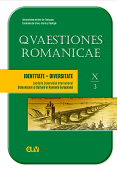Relazioni cinematografiche tra Italia e Romania durante la Seconda Guerra Mondiale
Cinematographic relationships between Italy and Romania during the Second World War
Author(s): Michelangelo Cardinaletti, Fabio MelelliSubject(s): Cultural history, WW II and following years (1940 - 1949), Film / Cinema / Cinematography, History of Art
Published by: Universitatea de Vest din Timişoara
Keywords: Italy; Romania; Second World War; Co-productions; Maria Cebotari;
Summary/Abstract: During the last years of the fascist regime, Italy and Romania intensified their cinematographic relationships, on the one hand with the participation of the famous romanian soprano Maria Cebotari in eight films of italian production, from Mutterlied (1937) by Carmine Gallone to Maria Malibran (1943) by Guido Brignone, relating to the operatic genre, one of the pillars of italian cinema during the 1930s and 1940s, as it perfectly responds to the "nationalistic" desires of the fascist hierarchies, and on the other with two films made in co-production between the two countries in a war-like scenario Odessa in fiamme (1942) by Carmine Gallone and La squadriglia bianca (Escadrila Alba, 1944) by Jon Sava, shot indoor at Cinecittà and externally in Romania. If Gallone's film can be found today on public internet platforms, Sava's film seems, at the current state of research, to be lost. The mediatic construction of a star personality like Cebotari – female equivalent of filmic-singing figures such as the contemporaries Beniamino Gigli and Tito Schipa – and the aesthetic and propaganda aspects of fascist war cinema tell a lot about the relationship between these two countries, culturally, ideologically and politically related and allied during the world conflict.
Journal: Quaestiones Romanicae
- Issue Year: X/2023
- Issue No: 3
- Page Range: 241-252
- Page Count: 12
- Language: Italian

